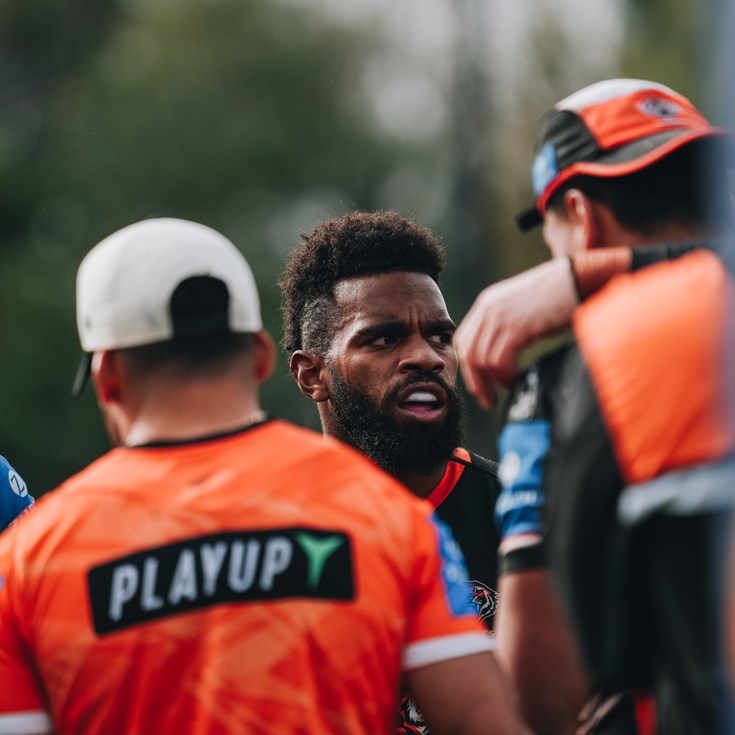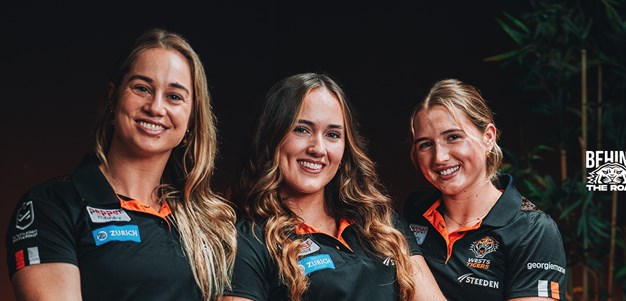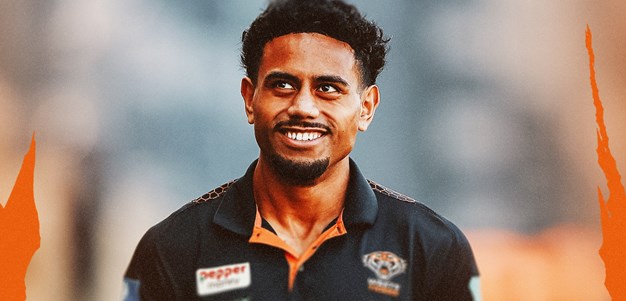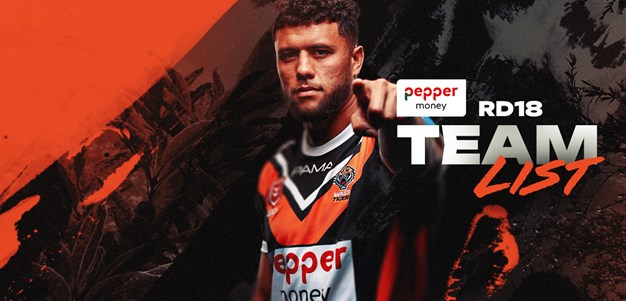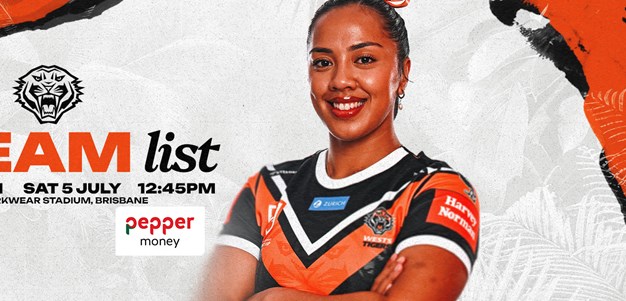In the lead up to Wests Tigers' Round 6 Heritage match against St George Illawarra, take the time to read about Wests Tigers halfback of the Century Keith Yappy Holman.
Born in Ballarat on September 11, 1925 to parents whom he never knew, Keith Victor Holman had the most distant upbringing from Rugby League that one could humanly have.
Living in poverty as a child, being looked after by a man known only as Holman who most likely was a relative, Keith grew up during Australias darkest days the post WWI era known as the Depression. For a long time, Keiths name was unclear even to him, but after the great generosity he received from this man Holman he had his surname changed by deed poll, adopting the name as his surname. It was many years later Keith learnt that Holman was his actual surname.
In the 1930s, Holman took Keith to Sydney, where he resided in a tin shed at Yarra Bay owned by the people he considered as his childhood parents, Mr and Mrs Schofield.
Mrs Schofield sent Keith to De La Salle Brothers School in Surry Hills, where he became friends with future test team-mate Burnie Purcell.
While at school he was first shown the game of Rugby League and fell in love with it. He was very quick and elusive on his feet. He was selected to play at halfback when representing his school alongside Purcell, under the tutelage of Souths player Jack Duck Walsh.
Once his schooling was completed, Holman signed up with the RAAF. He was posted in Ipswich for training. Holman played for CYM in Brisbane while serving as a chef for the RAAF with the 82 wing.
Keith later revealed he went up to his Chief Officer and said Excuse me Sir; Id like to be able to play football Sir, on a Saturday with CYM in Ipswich First Grade. The CO replied, Ill tell you what Ill do son. You can play on the Saturday, but youve got to double-up again on the Sunday and play for the RAAF against the Army and Navy. Keith was ecstatic, as he later revealed, it meant that he got every weekend off to play footy.
In November 1945, after the Japanese had surrendered in World War II, Holman was sent to Balikpapan in Borneo with the RAAF, transporting ex-prisoners of war and other Australian Armed forces back to Australia. It was during his time there that he almost lost his life in a bizarre incident.
It was after hed finished cleaning the makeshift kitchen, two natives were repairing a mechanism used to light the stoves. Petrol was poured down a pipe from tanks outside into a furnace inside. Then a match was sent down the pipe to light the fire inside. On this particular day, the natives were cleaning it, but were unaware it had leaked petrol onto the floor inside the kitchen. As Keith was leaving the room, a match was dropped down and the whole room exploded in flames. Keith received burns to his hands, chest and legs.
While serving, he was selected at halfback for the RAAF against Rest of Ipswich in a curtain raiser game before the England v Ipswich tour game in 1946. He kicked three field goals in the game.
He left the RAAF and returned to Sydney for a trial with Souths. They told him to come back and try out for a ball boy, because he was so short (56 or 168cm) they thought he was younger than he stated.
The legendary Cec Blinkhorn saw Holmans trials and lined him up with Manly, who were stringing together players for the debut season. In 1947 Holman played in Manlys lower grades. They graded him as a reserve for their third grade side before he was posted to Dubbo later in the year.
While playing in Dubbo in 1948, Wests centre Eric Bennett spotted Holman and insisted he trial with Wests. Bennett brought Holman back to Sydney where they resided with former Wests player Jack Drew in his Enfield home. Bennett, Drew and ex-player, Tom McGuinness, all worked together to help coach Holman extra skills for a halfback in attack and defence.
Holman played third and reserve grade for Wests in 1948. In 1949, Holman was graded in first grade, but struggled to get much game time as he was battling with NSW halfback Neville Hogan for a spot in Wests top side.
After a starring role in Wests 44-15 annihilation of Easts, earning Man of the Match honours, he was already being suggested for representative duties. Three weeks later he produced another starring role in Wests 23-0 shut-out of Canterbury. It was in this match that his combination with Frank Stanmore started to show.
Deft passing both sides, coupled with the ability to throw long, hard passes, later dubbed bullet passes as well as amazing agility, speed and determination in defence meant he was popping up all over the field all the time.
Neville Hogan left Wests for Young in 1950, opening the door for Holman to replace him in first grade.
Despite Wests slow start to the 1950 season, Holmans form was impeccable, however he was surprisingly omitted from both the Sydney Firsts and Seconds teams to play against Country. But when Keith Froome wasnt selected as NSW halfback for the interstate series against Queensland, Holman had a battle with Col Geelan for the vacant job. The selectors however couldnt ignore Holmans ability.
After a successful interstate series with NSW, Holman was named as halfback in the Probables team for their match against the Possibles to determine positions in the test side. Holman put in yet another stellar performance to earn a spot in the Test side.
Holman impressed in his first Test, even though he was targeted heavily by English halfback Tommy Bradshaw. Australia lost 6-4.
Holman lead Australia to a dominant 15-3 victory in the second test. So good was Holman that he picked up a number of 'Man of the Match' awards from various judges. It even lead the brilliant 1920s test halfback and selector Duncan Thompson to say of Holman, Ive seen few halfbacks pass with such rhythm and speed.
It was Thompsons advice to Holman at half time in the second test that swung the game Australias way, when he told Holman to take the line on, as the England defenders were tired and starting to hang back when he got the ball.
Keiths heroics continued in the third test when he helped guide Australia to win the deciding test and the Ashes for the first time since 1920. Making his test debut in that amazing third test was Holmans team mate from De La Salle Brothers, Burnie Purcell.
Holman and his teammates agreed after the game that they would refuse the bonus payments due to them for winning the game and the series, instead they wanted to receive trophies.
Holman told the Sydney Morning Herald after the series win, I would rather have the trophy. I would soon spend the money, but a trophy would give me something to look back on and remind me of the games. The NSWRL honoured the players wishes.
Holman returned to club football which saw Wests win their last six straight games to sneak into the finals. They beat Balmain 28-10 to make it to the Grand Final against the star studded Souths line-up, containing Keiths long-time friend Purcell.
Souths turned out to be too strong on the day, winning 21-15. Holman was awarded the Sunday Herald Player of The Year at the end of the season.
In 1951, Holman was named vice-captain of Wests. He played all 3 tests against a touring French team, regarded as one of the greatest teams to ever tour to Australia.
He again lead Wests to the finals, but they bowed out in the first week. Holman was voted the NSW Player of the Year in 1951.
1952 saw Holman become a household name and an automatic selection in any team. During the first half of the second test against New Zealand in 1952, Kiwi winger Cyril Eastlake made a break down the sideline. Holman attempted a diving tackle but missed and his head caught Eastlakes boot.
Holman was knocked out briefly, before regaining his feet, somewhat groggily. At halftime he collapsed in the sheds before regaining consciousness. He decided to continue playing, but he was severely hampered and the Kiwis won a high scoring game 49-25.
The selectors were very harsh of the team and cut several players from the third test, including Holman. Keith however regained his spot when he was named in the Kangaroo squad to tour England and France at seasons end.
While Holman was en-route to England, Wests defeated Souths in the Grand Final. It would be the only Grand Final Wests would win during Holmans playing career.
The 1952 Kangaroo tour is sadly remembered for the atrocious refereeing by the French officials against the Australian team, mostly directed at Holman for trivial scrum infringements.
The issue began in the first tour game in France and by the time the Third test rolled around, the Kangaroos were sick of it. In that Test, Holman was dubiously penalised for feeding a scrum incorrectly. French referee Rebas sent off Holman for allegedly swearing at him. Holman strongly denied the allegation and Australian captain Clive Churchill interjected, but the referee was insistent. Angered by the decision, Churchill motioned for his team to walk off in protest, before team manager Norm Robinson came onto the field with an interpreter to try and discuss the matter with the referee; however Rebas just walked away from them.
Holman remained on the ground and once play resumed, he tried to dive over for a try. While he was on the ground, French player Louis Mazon leapt on Holman with both knees after the tackle had been made. Rebas cautioned Mazon and ordered a scrum, before going on to ignore further French infringements and penalising the Australians for trivial issues. France won the game 13-5, and the series.
In 1954 while playing for NSW against the touring England side, Holman was the victim of a brutal incident which lead to the match being abandoned due to fighting.
Holman was alleged to have tripped England half Ray Price. Soon after from a scrum, Holman picked up the ball and ran into the ruck. He was tackled and held by two English forwards and then a third player ran in and punched Holman in the face. The sideline official ran onto the field and reported the incident. Referee Aub Oxford cautioned Price. Price spoke back to the referee, unhappy with the caution, and Oxford sent him off.
When play resumed, the English players were tackling high, with cocked fists and punching the NSW players. It quickly turned into an all-in brawl and no matter what Oxford tried to do he couldnt bring the fighting under control, so he walked off the field, leaving the players fighting on the pitch.
Holman played a starring role in Australias retention of the Ashes, albeit playing with an injured hip in the third test.
At the end of 1954, Holman was named in Australias inaugural World Cup squad and set sail for England. He also played for the ANZACs against Great Britain in an exhibition game at Bradford. Australia finished third out of the four competing teams in the World Cup. They then toured with the New Zealand team to Los Angeles and played an exhibition game which Australia won. Holman was declared Man of the Match and awarded the Dick Hyland trophy.
Most notably though, it was in 1954 that Keith Holman earned his now famous nickname yappy. At an interview in 2000, he revealed how the name came about:
I was captain of Western Suburbs and naturally being the captain, when a decision was made by the referee I'd say "excuse me sir, what was that for? excuse me sir, what was that for?". The bloke that gave me the nickname "Yappy" happened to be Darcy Lawler (prominent Rugby League referee of the 50s). I don't think I can say what he told me, he said "for Christ's sake Yappy shut your #%$*&@ mouth" and that's how it stuck.
In 1955, Holman was controversially omitted from the NSW side to play the touring French side, along with Clive Churchill; however both were recalled for the test series, which the Kangaroos narrowly lost.
Despite his clubs poor season, Holman still managed to win the New South Wales Player of the Year Award in 1956.
Holman played a supporting role beside Greg Hawick, who was sublime in NSWs 49-11 demolition of Queensland in 1957. Their dominant showing earned them automatic selection for the Australian side to play in the World Cup that year on home soil. In the first game, Holman was sandwiched in a heavy tackle and twisted his knee. He was unable to pass future fitness tests and didnt play again in the cup.
Holman played in all three tests against Great Britain on home soil in 1958 and was one of the best on field in the opening test of the series, which Australia won 25-8. But the form could not be replicated again in the series, Australia losing a close second test before the Lions trampled them 40-17 in the decider. That would be Holmans last test.
Despite being a member of the Test side which lost the Ashes, Holman still managed to win his third NSW Player of the year title in 1958.
The 1961 Wests side was quite dominant, losing just 3 of their 18 games. They made it to the Grand Final but were no match for a rampant St.George side who won 22-0. Holman pulled a muscle in his leg in the first half, but continued playing. A stray swinging arm by Reg Gasnier narrowly missed Holmans head during the second half. The full time siren sounded, ending the stellar 13 year career of Keith Holman.
After the game, Keith spoke with Gasnier, saying I wish to Christ youd have hit me! Gasnier replied Why? and Keith said I would have rather been carried off than walked off after that game!
Despite the convincing defeat, the fans gathered at the ground on that day and gave an emotional and thorough ovation to Holman as he left the field for the last time as a player.
Holman became a referee in 1962 and in 1965 he made his first grade referee debut.
In 1971 he refereed the City v Country game, the second Interstate match between NSW and QLD and the Grand Final, which Keith recalls was the highlight of his career as a referee.
However there was a low point that year during his only time officiating an interstate game at Lang Park. In a fiercely fought battle Holman sent off 4 players, 3 of them Queenslanders, for stiff-arms, punching and kicking. The last player to be sent off, Russell Hughes (Queensland) happened within the last ten minutes of the game and was met by a barrage of beer cans and bottles being thrown onto the field by seething fans.
In 1972 he again controlled the City v Country game as well as the first two tests between Australia and New Zealand, making him the first man to play and referee at international level.
He was again the referee for the City v Country game in 1973 and then refereed in every round of 1974 before hanging up the whistle.
From 1964 to 1967 Holman toured Papua New Guinea as part of the National Sports Foundation, lecturing and coaching Rugby League. In 1974 he was made a life member of the Papua New Guinea Rugby League.
Keiths endurance on the field, as a player and referee, was due to his discipline in fitness, health and training. He became good friends and trained with athletes George Barnes (boxer), Alan Davidson (cricket), Marlene Mathews and Gloria Cooke (both track and field). Keith believed that being physically fit lead to being mentally fit and vice versa.
His retirement from the game was again short lived, as he became coach of Port Kembla for 1975-76 before returning to Wests as their coach in 1977. His return to coaching at Wests was initially fruitful, winning the pre-season AMCO Cup competition.
The joy was short lived as Wests won just 7 of their 22 games in 1977. Holman stepped down at the end of the year signalling an end to his career. Holman was made a Member of the Order of the British Empire (MBE) for his services to Rugby League in 1977.
Keith took on a position as chairman of the NSW Coaching Panel from 1981 til 1986, after having previously been a board member back in 1962.
In 1991, Holman was inducted into the Sport Australia Hall of Fame.
Keith worked tirelessly with juniors in the Western Suburbs and was recognised in the greatest way possible when he became the first player to have a football team named after him (Holman JRLFC, based at Enfield).
Holman said of the accolades:
I feel that to achieve these things, for people to think that well of you, to give you those rewards, I couldn't believe it. I had the arse out of my pants as a kid, now I've got a lovely home and a lovely wife. I couldn't wish for anything more.
Keith Holman was inducted into the Australian Rugby League Hall of Fame in 2003.
A panel of experts selected Holman as halfback in an Australian Team of the 50s in 2007.
In 2008, Holman was named as one Australian Rugby Leagues top 100 players in the Centenary celebrations. He was the halfback for the Western Suburbs and Wests Tigers (a team of the best players from Balmain, Western Suburbs and Wests Tigers since 1908) teams of the century. He was also one of the six inaugural players to be inducted into the Western Suburbs Hall of Fame.
Keith Holmans life and being was best summed up by Keith himself when asked what it was about the Magpies that kept him involved with the club for over half a century:
I was an orphan and people gave me a chance, and I want to give the kids a chance. I think that's the beautiful part of it. Mr and Mrs Schofield gave me a home, I've got a wonderful family, I've got two daughters and a son, I've got seven grandchildren and everything I do I want them to be proud of me.
Keith Holman passed away on October 10, 2011. No one, not even himself, knew his name when he was child.
But many people around the world know his name now.
And theyll never forget it.
Andrew Ferguson writes for Men of League Magazine. View his website RLProject.
Born in Ballarat on September 11, 1925 to parents whom he never knew, Keith Victor Holman had the most distant upbringing from Rugby League that one could humanly have.
Living in poverty as a child, being looked after by a man known only as Holman who most likely was a relative, Keith grew up during Australias darkest days the post WWI era known as the Depression. For a long time, Keiths name was unclear even to him, but after the great generosity he received from this man Holman he had his surname changed by deed poll, adopting the name as his surname. It was many years later Keith learnt that Holman was his actual surname.
In the 1930s, Holman took Keith to Sydney, where he resided in a tin shed at Yarra Bay owned by the people he considered as his childhood parents, Mr and Mrs Schofield.
Mrs Schofield sent Keith to De La Salle Brothers School in Surry Hills, where he became friends with future test team-mate Burnie Purcell.
While at school he was first shown the game of Rugby League and fell in love with it. He was very quick and elusive on his feet. He was selected to play at halfback when representing his school alongside Purcell, under the tutelage of Souths player Jack Duck Walsh.
Once his schooling was completed, Holman signed up with the RAAF. He was posted in Ipswich for training. Holman played for CYM in Brisbane while serving as a chef for the RAAF with the 82 wing.
Keith later revealed he went up to his Chief Officer and said Excuse me Sir; Id like to be able to play football Sir, on a Saturday with CYM in Ipswich First Grade. The CO replied, Ill tell you what Ill do son. You can play on the Saturday, but youve got to double-up again on the Sunday and play for the RAAF against the Army and Navy. Keith was ecstatic, as he later revealed, it meant that he got every weekend off to play footy.
In November 1945, after the Japanese had surrendered in World War II, Holman was sent to Balikpapan in Borneo with the RAAF, transporting ex-prisoners of war and other Australian Armed forces back to Australia. It was during his time there that he almost lost his life in a bizarre incident.
It was after hed finished cleaning the makeshift kitchen, two natives were repairing a mechanism used to light the stoves. Petrol was poured down a pipe from tanks outside into a furnace inside. Then a match was sent down the pipe to light the fire inside. On this particular day, the natives were cleaning it, but were unaware it had leaked petrol onto the floor inside the kitchen. As Keith was leaving the room, a match was dropped down and the whole room exploded in flames. Keith received burns to his hands, chest and legs.
While serving, he was selected at halfback for the RAAF against Rest of Ipswich in a curtain raiser game before the England v Ipswich tour game in 1946. He kicked three field goals in the game.
He left the RAAF and returned to Sydney for a trial with Souths. They told him to come back and try out for a ball boy, because he was so short (56 or 168cm) they thought he was younger than he stated.
The legendary Cec Blinkhorn saw Holmans trials and lined him up with Manly, who were stringing together players for the debut season. In 1947 Holman played in Manlys lower grades. They graded him as a reserve for their third grade side before he was posted to Dubbo later in the year.
While playing in Dubbo in 1948, Wests centre Eric Bennett spotted Holman and insisted he trial with Wests. Bennett brought Holman back to Sydney where they resided with former Wests player Jack Drew in his Enfield home. Bennett, Drew and ex-player, Tom McGuinness, all worked together to help coach Holman extra skills for a halfback in attack and defence.
Holman played third and reserve grade for Wests in 1948. In 1949, Holman was graded in first grade, but struggled to get much game time as he was battling with NSW halfback Neville Hogan for a spot in Wests top side.
After a starring role in Wests 44-15 annihilation of Easts, earning Man of the Match honours, he was already being suggested for representative duties. Three weeks later he produced another starring role in Wests 23-0 shut-out of Canterbury. It was in this match that his combination with Frank Stanmore started to show.
Deft passing both sides, coupled with the ability to throw long, hard passes, later dubbed bullet passes as well as amazing agility, speed and determination in defence meant he was popping up all over the field all the time.
Neville Hogan left Wests for Young in 1950, opening the door for Holman to replace him in first grade.
Despite Wests slow start to the 1950 season, Holmans form was impeccable, however he was surprisingly omitted from both the Sydney Firsts and Seconds teams to play against Country. But when Keith Froome wasnt selected as NSW halfback for the interstate series against Queensland, Holman had a battle with Col Geelan for the vacant job. The selectors however couldnt ignore Holmans ability.
After a successful interstate series with NSW, Holman was named as halfback in the Probables team for their match against the Possibles to determine positions in the test side. Holman put in yet another stellar performance to earn a spot in the Test side.
Holman impressed in his first Test, even though he was targeted heavily by English halfback Tommy Bradshaw. Australia lost 6-4.
Holman lead Australia to a dominant 15-3 victory in the second test. So good was Holman that he picked up a number of 'Man of the Match' awards from various judges. It even lead the brilliant 1920s test halfback and selector Duncan Thompson to say of Holman, Ive seen few halfbacks pass with such rhythm and speed.
It was Thompsons advice to Holman at half time in the second test that swung the game Australias way, when he told Holman to take the line on, as the England defenders were tired and starting to hang back when he got the ball.
Keiths heroics continued in the third test when he helped guide Australia to win the deciding test and the Ashes for the first time since 1920. Making his test debut in that amazing third test was Holmans team mate from De La Salle Brothers, Burnie Purcell.
Holman and his teammates agreed after the game that they would refuse the bonus payments due to them for winning the game and the series, instead they wanted to receive trophies.
Holman told the Sydney Morning Herald after the series win, I would rather have the trophy. I would soon spend the money, but a trophy would give me something to look back on and remind me of the games. The NSWRL honoured the players wishes.
Holman returned to club football which saw Wests win their last six straight games to sneak into the finals. They beat Balmain 28-10 to make it to the Grand Final against the star studded Souths line-up, containing Keiths long-time friend Purcell.
Souths turned out to be too strong on the day, winning 21-15. Holman was awarded the Sunday Herald Player of The Year at the end of the season.
In 1951, Holman was named vice-captain of Wests. He played all 3 tests against a touring French team, regarded as one of the greatest teams to ever tour to Australia.
He again lead Wests to the finals, but they bowed out in the first week. Holman was voted the NSW Player of the Year in 1951.
1952 saw Holman become a household name and an automatic selection in any team. During the first half of the second test against New Zealand in 1952, Kiwi winger Cyril Eastlake made a break down the sideline. Holman attempted a diving tackle but missed and his head caught Eastlakes boot.
Holman was knocked out briefly, before regaining his feet, somewhat groggily. At halftime he collapsed in the sheds before regaining consciousness. He decided to continue playing, but he was severely hampered and the Kiwis won a high scoring game 49-25.
The selectors were very harsh of the team and cut several players from the third test, including Holman. Keith however regained his spot when he was named in the Kangaroo squad to tour England and France at seasons end.
While Holman was en-route to England, Wests defeated Souths in the Grand Final. It would be the only Grand Final Wests would win during Holmans playing career.
The 1952 Kangaroo tour is sadly remembered for the atrocious refereeing by the French officials against the Australian team, mostly directed at Holman for trivial scrum infringements.
The issue began in the first tour game in France and by the time the Third test rolled around, the Kangaroos were sick of it. In that Test, Holman was dubiously penalised for feeding a scrum incorrectly. French referee Rebas sent off Holman for allegedly swearing at him. Holman strongly denied the allegation and Australian captain Clive Churchill interjected, but the referee was insistent. Angered by the decision, Churchill motioned for his team to walk off in protest, before team manager Norm Robinson came onto the field with an interpreter to try and discuss the matter with the referee; however Rebas just walked away from them.
Holman remained on the ground and once play resumed, he tried to dive over for a try. While he was on the ground, French player Louis Mazon leapt on Holman with both knees after the tackle had been made. Rebas cautioned Mazon and ordered a scrum, before going on to ignore further French infringements and penalising the Australians for trivial issues. France won the game 13-5, and the series.
In 1954 while playing for NSW against the touring England side, Holman was the victim of a brutal incident which lead to the match being abandoned due to fighting.
Holman was alleged to have tripped England half Ray Price. Soon after from a scrum, Holman picked up the ball and ran into the ruck. He was tackled and held by two English forwards and then a third player ran in and punched Holman in the face. The sideline official ran onto the field and reported the incident. Referee Aub Oxford cautioned Price. Price spoke back to the referee, unhappy with the caution, and Oxford sent him off.
When play resumed, the English players were tackling high, with cocked fists and punching the NSW players. It quickly turned into an all-in brawl and no matter what Oxford tried to do he couldnt bring the fighting under control, so he walked off the field, leaving the players fighting on the pitch.
Holman played a starring role in Australias retention of the Ashes, albeit playing with an injured hip in the third test.
At the end of 1954, Holman was named in Australias inaugural World Cup squad and set sail for England. He also played for the ANZACs against Great Britain in an exhibition game at Bradford. Australia finished third out of the four competing teams in the World Cup. They then toured with the New Zealand team to Los Angeles and played an exhibition game which Australia won. Holman was declared Man of the Match and awarded the Dick Hyland trophy.
Most notably though, it was in 1954 that Keith Holman earned his now famous nickname yappy. At an interview in 2000, he revealed how the name came about:
I was captain of Western Suburbs and naturally being the captain, when a decision was made by the referee I'd say "excuse me sir, what was that for? excuse me sir, what was that for?". The bloke that gave me the nickname "Yappy" happened to be Darcy Lawler (prominent Rugby League referee of the 50s). I don't think I can say what he told me, he said "for Christ's sake Yappy shut your #%$*&@ mouth" and that's how it stuck.
In 1955, Holman was controversially omitted from the NSW side to play the touring French side, along with Clive Churchill; however both were recalled for the test series, which the Kangaroos narrowly lost.
Despite his clubs poor season, Holman still managed to win the New South Wales Player of the Year Award in 1956.
Holman played a supporting role beside Greg Hawick, who was sublime in NSWs 49-11 demolition of Queensland in 1957. Their dominant showing earned them automatic selection for the Australian side to play in the World Cup that year on home soil. In the first game, Holman was sandwiched in a heavy tackle and twisted his knee. He was unable to pass future fitness tests and didnt play again in the cup.
Holman played in all three tests against Great Britain on home soil in 1958 and was one of the best on field in the opening test of the series, which Australia won 25-8. But the form could not be replicated again in the series, Australia losing a close second test before the Lions trampled them 40-17 in the decider. That would be Holmans last test.
Despite being a member of the Test side which lost the Ashes, Holman still managed to win his third NSW Player of the year title in 1958.
The 1961 Wests side was quite dominant, losing just 3 of their 18 games. They made it to the Grand Final but were no match for a rampant St.George side who won 22-0. Holman pulled a muscle in his leg in the first half, but continued playing. A stray swinging arm by Reg Gasnier narrowly missed Holmans head during the second half. The full time siren sounded, ending the stellar 13 year career of Keith Holman.
After the game, Keith spoke with Gasnier, saying I wish to Christ youd have hit me! Gasnier replied Why? and Keith said I would have rather been carried off than walked off after that game!
Despite the convincing defeat, the fans gathered at the ground on that day and gave an emotional and thorough ovation to Holman as he left the field for the last time as a player.
Holman became a referee in 1962 and in 1965 he made his first grade referee debut.
In 1971 he refereed the City v Country game, the second Interstate match between NSW and QLD and the Grand Final, which Keith recalls was the highlight of his career as a referee.
However there was a low point that year during his only time officiating an interstate game at Lang Park. In a fiercely fought battle Holman sent off 4 players, 3 of them Queenslanders, for stiff-arms, punching and kicking. The last player to be sent off, Russell Hughes (Queensland) happened within the last ten minutes of the game and was met by a barrage of beer cans and bottles being thrown onto the field by seething fans.
In 1972 he again controlled the City v Country game as well as the first two tests between Australia and New Zealand, making him the first man to play and referee at international level.
He was again the referee for the City v Country game in 1973 and then refereed in every round of 1974 before hanging up the whistle.
From 1964 to 1967 Holman toured Papua New Guinea as part of the National Sports Foundation, lecturing and coaching Rugby League. In 1974 he was made a life member of the Papua New Guinea Rugby League.
Keiths endurance on the field, as a player and referee, was due to his discipline in fitness, health and training. He became good friends and trained with athletes George Barnes (boxer), Alan Davidson (cricket), Marlene Mathews and Gloria Cooke (both track and field). Keith believed that being physically fit lead to being mentally fit and vice versa.
His retirement from the game was again short lived, as he became coach of Port Kembla for 1975-76 before returning to Wests as their coach in 1977. His return to coaching at Wests was initially fruitful, winning the pre-season AMCO Cup competition.
The joy was short lived as Wests won just 7 of their 22 games in 1977. Holman stepped down at the end of the year signalling an end to his career. Holman was made a Member of the Order of the British Empire (MBE) for his services to Rugby League in 1977.
Keith took on a position as chairman of the NSW Coaching Panel from 1981 til 1986, after having previously been a board member back in 1962.
In 1991, Holman was inducted into the Sport Australia Hall of Fame.
Keith worked tirelessly with juniors in the Western Suburbs and was recognised in the greatest way possible when he became the first player to have a football team named after him (Holman JRLFC, based at Enfield).
Holman said of the accolades:
I feel that to achieve these things, for people to think that well of you, to give you those rewards, I couldn't believe it. I had the arse out of my pants as a kid, now I've got a lovely home and a lovely wife. I couldn't wish for anything more.
Keith Holman was inducted into the Australian Rugby League Hall of Fame in 2003.
A panel of experts selected Holman as halfback in an Australian Team of the 50s in 2007.
In 2008, Holman was named as one Australian Rugby Leagues top 100 players in the Centenary celebrations. He was the halfback for the Western Suburbs and Wests Tigers (a team of the best players from Balmain, Western Suburbs and Wests Tigers since 1908) teams of the century. He was also one of the six inaugural players to be inducted into the Western Suburbs Hall of Fame.
Keith Holmans life and being was best summed up by Keith himself when asked what it was about the Magpies that kept him involved with the club for over half a century:
I was an orphan and people gave me a chance, and I want to give the kids a chance. I think that's the beautiful part of it. Mr and Mrs Schofield gave me a home, I've got a wonderful family, I've got two daughters and a son, I've got seven grandchildren and everything I do I want them to be proud of me.
Keith Holman passed away on October 10, 2011. No one, not even himself, knew his name when he was child.
But many people around the world know his name now.
And theyll never forget it.
Andrew Ferguson writes for Men of League Magazine. View his website RLProject.
